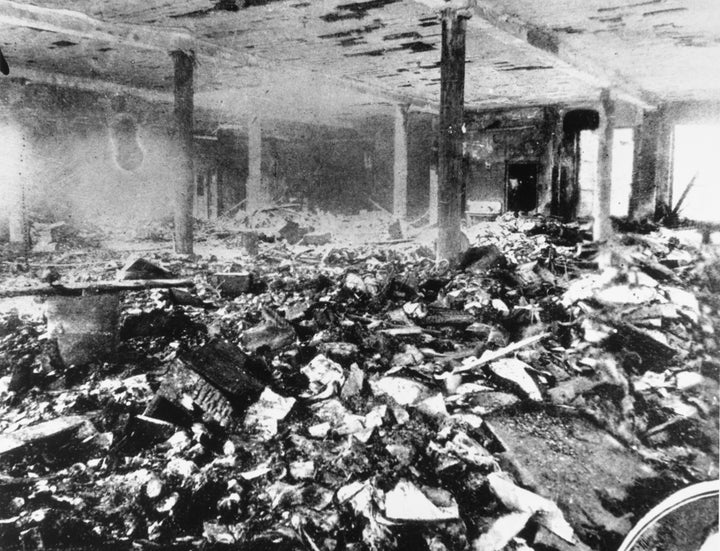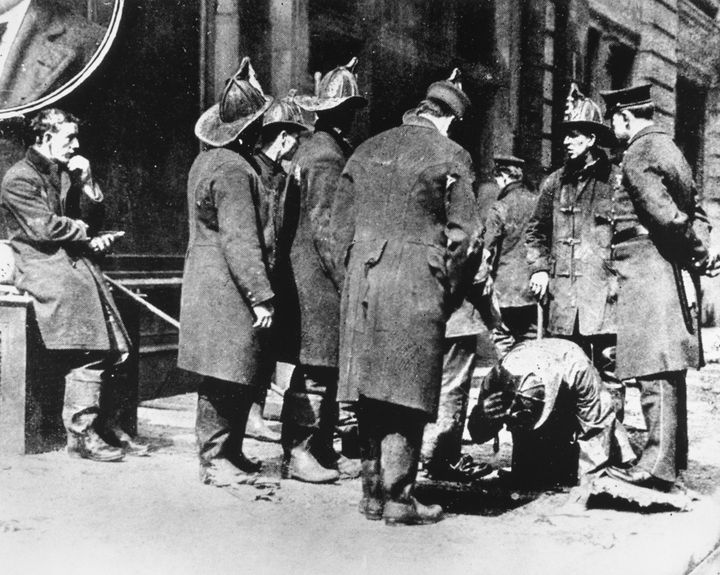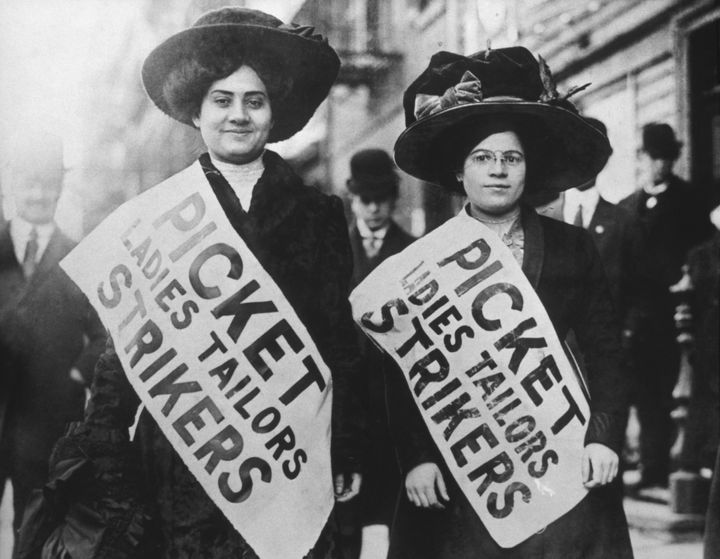
Over the last week or so, you might’ve come across the online discourse about the Roman Empire. To sum it up, there’s been a social media trend in which people ask the men in their lives how often they think about ancient Rome. The answer for many: quite frequently.
But amid the online chatter about men’s surprising (or perhaps unsurprising) fixation with the Roman Empire came another interesting question. What’s the equivalent for women?
The sinking of the Titanic, the six wives of Henry VIII, the Salem witch trials and the death of the Romanov family are among the more popular suggestions (along with non-historical fixations like the fear of kidnapping and anxiety about past social interactions). But another tragic disaster that looms particularly large in this conversation is the Triangle Shirtwaist Factory fire.
One of the deadliest industrial disasters in the U.S., the Triangle Shirtwaist Factory fire occurred on March 25, 1911, in New York City and claimed the lives of 146 garment workers over the course of 15 minutes. Of the 146 victims, 123 were women — some were as young as 14.
“This was a fire at a state-of-the-art clothing factory in Greenwich Village in a building that didn’t look like a factory, so most people who walked by it every day had no idea what was going on inside,” Mary Anne Trasciatti, president of the Remember the Triangle Fire Coalition and director of Hofstra University’s labor studies program, told HuffPost. “And what was going on inside was that a number of workers were crowded into a space that should not have had as many of them in there as it did, and a fire broke out.”
The Triangle Shirtwaist Factory occupied the top three floors of a 10-story building by Washington Square Park. Although there were multiple exits, the flames quickly blocked one stairway, and the doors to another had been locked, effectively trapping the workers inside.
A poorly constructed fire escape collapsed under the weight of those trying to flee, dropping them to their deaths. Unable to safely escape the blaze, dozens of workers opted to jump from the high windows rather than succumb to the smoke and fire.

“Because there were inadequate safety measures and locked doors, the workers were not able to get to safety, and 146 of them died unnecessarily,” Trasciatti said. “It was a horrible, terrible tragedy. Working people should never go to work and not come home.”
Unlike many other labor tragedies, however, the devastating disaster led to positive change.
“Workers were outraged, particularly because so many of the those who died were young girls,” Trasciatti said. “People saw them jump out the windows, so they couldn’t ignore what was happening inside these buildings any longer. They took action, and they actually won. They got workplace protections, and they paved the way for stronger unions.”
In addition to poor labor conditions, many historians cite the Triangle Waist Company’s anti-union stance as a contributing factor to the extent of the loss.
“There were locked doors to keep the workers from taking breaks, gathering together for fun to chat and to keep union organizers out,” Trasciatti said. Purported concerns that workers would steal material were also used to justify this practice.
In 1909, Triangle Shirtwaist Factory workers participated in the mass labor strike known as the Uprising of the 20,000, but they ultimately failed to secure union recognition.
“And so some of the safety measures that might saved their lives had they been able to join the International Ladies’ Garment Workers’ Union were not implemented,” Trasciatti noted.

The fact that interest in the Triangle Shirtwaist Factory fire has continued into 2023, particularly among women, is understandable to Trasciatti, who developed a strong connection to the tragedy as she learned more about it.
“What really struck me about the story was how young workers were, how innocent they were and how many of them were female,” she said. “I think that’s why so many women, particularly young women, respond to this story ― because this could be us, right?”
The 123 women who died ranged from the ages of 14 to 43.
“These were working girls who were full of life and who through no fault of their own lost their lives because of inadequate workplace safety measures,” Trasciatti said. “Many were interested in fashion, and although they couldn’t afford the higher-end blouses they made as Triangle workers, they would gussy up their own modest clothing and make it pretty. They liked to have fun. So it resonates with young women today who can see themselves in them.”
Young women made up a large portion of the garment industry workforce in the early 20th century for a number of reasons, some of which may feel familiar to this day.
“They were a cheaper labor force, which meant more profit for the bosses,” Trasciatti said. “Women’s work was supplemental income because they weren’t typically the ones supporting a family, so they were paid lower wages compared to men. Their commitment to the job wasn’t considered as great ― they would be more likely to leave if they got married or had children too.”
She added that women were also considered suited to the delicate work required in garment factories. Sewing was a common skill for girls within the Italian and Jewish communities that many of these workers were part of.
“One of the things not to overlook with Triangle was that not only were they women workers, but they were largely immigrant workers,” Trasciatti explained. “So many of those who died were embedded in family networks, which makes it all the more tragic because so many families were just devastated by the loss.”
Several pairs of sisters perished that day. The Maltese family lost a mother and two daughters ― all of the female members of the immediate family.
Although it’s been more than 100 years since the Triangle Shirtwaist Factory fire, most of us can feel its legacy in our everyday lives.
“My mom was a garment worker and she always said, ‘We knew we were safe at work because of what had happened to those poor girls at Triangle,’” Trasciatti said. “We’re all more protected now in our workplaces ― we have emergency exits, fire escapes, sprinklers and fire drills because of what happened to those workers.”
She emphasised the role of workers and politicians who were infuriated by the unnecessary deaths in pressuring the government to pass laws and do more to protect workers. Frances Perkins, who witnessed the fire firsthand, went on to become the first female secretary of labor under President Franklin D. Roosevelt.
“It’s important to remember Triangle because it’s a reminder that the government does things to keep us safe from dangerous conditions and make our lives better when we demand it,” Trasciatti said.

The importance of workplace safety and dignity remains relevant in 2023 amid labor strikes and concerns over poor working conditions.
“Immigrant workers are still seen as expendable, and we tend to hire them for dangerous jobs,” Trasciatti said. “But we need to keep reminding ourselves that no group of workers is expendable, that immigrant workers make valuable contributions to our communities.”
Today’s labor activists still draw inspiration from the fire and the bravery of those who fought to keep workers safe in the aftermath.
“I think there’s a misconception that these kinds of things don’t happen anymore,” Trasciatti said. “But we saw workers dying on the job this summer because they didn’t have water breaks or air conditioning in their vehicles. We saw workers during COVID dying on the job because they didn’t have protective equipment.”
The garment industry continues to put workers in danger as well, but now it’s happening overseas. In 2012, at least 117 people died in a fire at a factory in Bangladesh that produced clothing ― months later, a garment factory building collapse killed more than 1,1000 workers.
On the 100th anniversary of the Triangle Shirtwaist Factory fire, Bangladeshi labor activist and former garment worker Kalpona Akter declared, “In Bangladesh, it’s not 2011 — it’s 1911.”
“In a system that often puts profit ahead of human life, we’re going to see Triangle fires happen again and again,” Trasciatti said. “It might not be at a garment factory in Greenwich Village, but other places around the world. The issue of ensuring that workers are safe on the job and have the right to organize into unions to protect themselves remains with us.”
She encouraged those who are interested in the Triangle Shirtwaist Factory fire to read the growing body of literature on the disaster and visit New York City’s new memorial to the victims, which will be dedicated on Oct. 11.
“But also I would say, look around and see what you can do to make the world around you a better place, because that’s what the survivors and eyewitnesses to the fire did,” Trasciatti said. “They did not let their grief or fear stop them.”
She pointed to the suffragists who were horrified by the fire and therefore were encouraged to push harder for the right to vote for women. They recognised the need to elect politicians who would take their needs into consideration.
“People took this and turned it into a lesson and demanded to be treated with dignity and respect on and off the job,” Trasciatti said. “Consider what you can do, even just in your small corner of the world. If everybody does something, nobody has to do everything.”